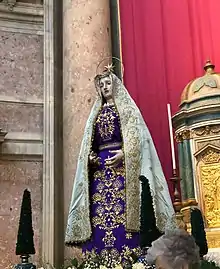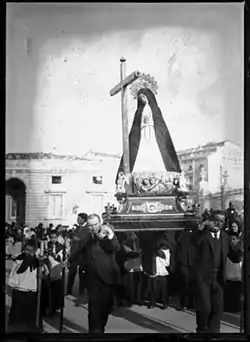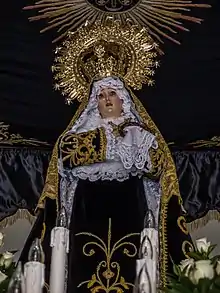Our Lady of Solitude
Our Lady of Solitude (Spanish: María de la Soledad) is a title of Mary (mother of Jesus) and a special form of Marian devotion practised in Spanish-speaking countries to commemorate the solitude of Mary on Holy Saturday. Variant names include Nuestra Señora de la Soledad, Maria Santisima, Nuestra Señora Dolorosisima de la Soledad, and Virgen de la Soledad.
Our Lady of Solitude | |
|---|---|
 Our Lady of Solitude of the Royal and Venerable Confraternity of the Most Blessed Sacrament of Mafra | |
| Venerated in | Roman Catholic Church |
| Part of a series on the |
| Mariology of the Catholic Church |
|---|
 |
|
|
History
The title originates with Queen Juana lamenting the early death of her husband Philip I of Castile in 1506.[1]
Feast

María de la Soledad's feast day is celebrated on December 18 in Spanish-speaking countries, and on Holy Saturday in English-speaking countries.[2]
The Our Lady of Solitude of the convent of the Our Lady of Victory
The image of Our Lady of Solitude was a carving made by the sculptor Gaspar Becerra (1520-1570) for the late convent of Our Lady of Victory in Madrid, in whose church he had an important chapel.
Isabel de Valois, wife of Felipe II, had in his private oratory a painting that she had brought with her from France and that represented the Virgin of the Solitude. The image of the picture aroused great devotion in the friars of the Order of the Minims of San Francisco de Paula, who had settled in Madrid following in the footsteps of the monarch. The friars asked permission to the queen to make a copy of the image in order to venerate her in the chapel of his convent of Our Lady of Victory. Gaspar Becerra was the sculptor.
From the beginning, the image was intended to be "vestidera", with only the head and hands carved and the rest a wooden frame covered with clothes. It seems that on the initiative of the Countess of Ureña, Dña María de la Cueva y Toledo, the queen's main waitress, she wore her own outfit of a noble widow of the time; this characteristic attire added to other peculiarities – such as wearing a diadem in place of crown, or be accompanied by the symbols of the Passion – constituted a true revolution in the typology of Marian images.[3]
In 1565, finally, after more than a year of work, the statue of Our Lady of Solitude was presented to the convent of Our Lady of Victory.
Patroness
María de la Soledad is the patroness of Badajos and Parla, Spain; Porto Covo, Portugal; Oaxaca and Acapulco,[4] Mexico; and of Cavite Province, Philippines, under the name Nuestra Señora de la Soledad de Porta Vaga.
The Mission Nuestra Señora de la Soledad in Soledad, California, was devoted to María de la Soledad.
Name
The given name María de la Soledad, often shortened to Marisol or Soledad, is used in Spanish-speaking countries.
See also
- Our Lady of Sorrows
- Soledad (disambiguation) mentions many people, places, and institutions named for María de la Soledad
Notes
- Catholic Encyclopedia, 1912 14:152
- "Archived copy". Archived from the original on 2013-01-24. Retrieved 2012-12-28.CS1 maint: archived copy as title (link)
- Sánchez de Madariaga, Elena (2008). La Virgen de la Soledad, la difusión de un culto en el Madrid barroco. La imagen religiosa en la Monarquía hispánica. Usos y espacios. Casa de Velázquez. ISBN 978-84-96820-12-8.
- "Archived copy". Archived from the original on 2012-07-18. Retrieved 2012-12-28.CS1 maint: archived copy as title (link)
External links
 Media related to Our Lady of Solitude at Wikimedia Commons
Media related to Our Lady of Solitude at Wikimedia Commons
